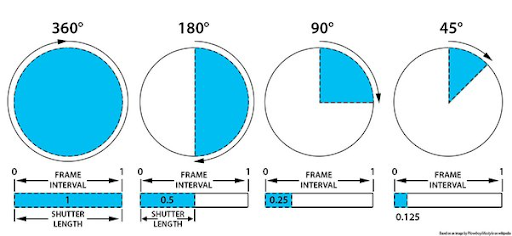Why Shutter Speed Matters in Video
The relationship between shutter speed and frame rate is a fundamental concept in videography, with the widely accepted 180-degree rule suggesting that shutter speed should be set to double the frame rate for optimal results. This technique, rooted in traditional film cinematography, aims to create natural-looking motion blur and a smooth, cinematic appearance in video footage.
180-Degree Shutter Rule Explained
The 180-degree shutterrule originates from the mechanical motion picture film camera, which used a rotating shutter to expose film for half of its rotation cycle[1]. In digital terms, this translates to setting the shutter speed to double the frame rate, creating a natural motion blur that mimics how the human eye perceives movement[2]. For example:
- 24 fps video should use a 1/48 or 1/50 shutter speed
- 30 fps video should use a 1/60 shutter speed
- 60 fps video should use a 1/120 shutter speed
This principle helps maintain a consistent cadence throughout the footage, ensuring smooth and realistic motion that viewers are accustomed to seeing in professional productions[1]. While modern digital cameras offer more flexibility, adhering to this rule can help achieve a cinematic look that has become the standard in filmmaking[3].
Benefits of Matching Shutter Speed
Adhering to the principle of matching shutter speed to frame rate offers several advantages for videographers. It helps prevent unwanted motion blur, ensuring clarity in fast-paced scenes like sports or action shots[1]. This technique also maintains a consistent look throughout the video, enhancing viewer engagement and immersion[2]. Additionally, it allows for smoother slow-motion footage when shooting at higher frame rates, as the proper shutter speed ensures each frame is crisp and well-defined. By following this guideline, filmmakers can achieve a professional, cinematic quality that audiences have come to expect from well-produced video content.
Shutter Speed Settings Examples
Different frame rates and their corresponding shutter speeds are commonly used in various filming scenarios:
- 24 fps with 1/48 or 1/50 shutter speed: Standard for cinematic productions
- 30 fps with 1/60 shutter speed: Typical for television and online video content
- 60 fps with 1/120 shutter speed: Used for smooth slow-motion footage or sports broadcasting
- 120 fps with 1/240 shutter speed: Ideal for capturing high-speed action or creating dramatic slow-motion effects
When shooting outdoors in bright conditions, higher shutter speeds may be necessary to avoid overexposure. In such cases, using neutral density (ND) filters can help maintain the desired shutter speed while controlling light intake[1][2].
Artistic Flexibility in Filming
While the 180-degree shutter rule provides a foundation for cinematic motion, filmmakers often break this guideline for creative purposes. Using faster shutter speeds can create a staccato effect, famously employed in the opening scene of "Saving Private Ryan" to heighten tension[2]. Conversely, slower shutter speeds can produce a dreamy, ethereal look. Some videographers intentionally use higher shutter speeds to achieve a unique visual style, as seen in certain music videos and commercial work. This flexibility allows directors to manipulate the viewer's perception of motion and time, enhancing the emotional impact of scenes or creating distinctive visual signatures for their projects[2].

Comments
Post a Comment